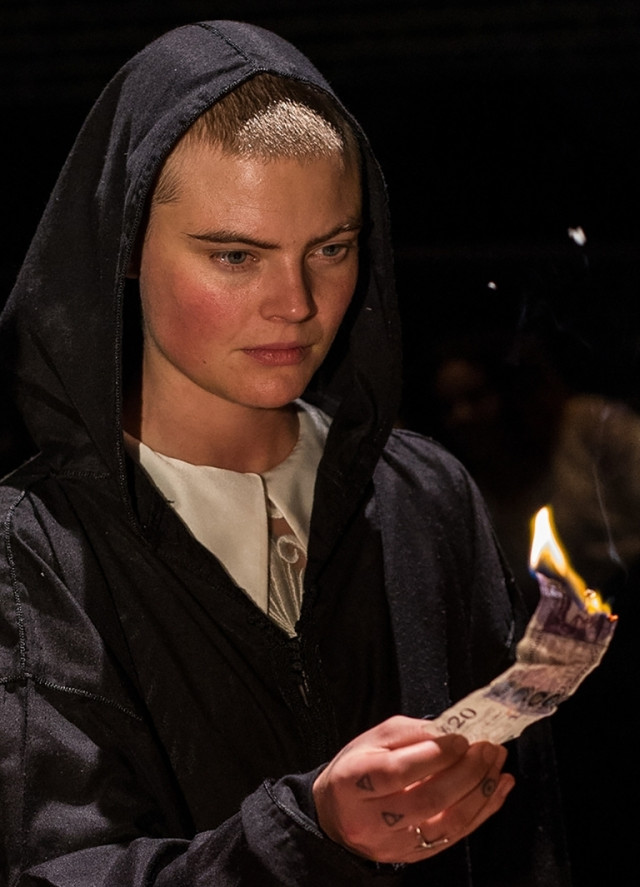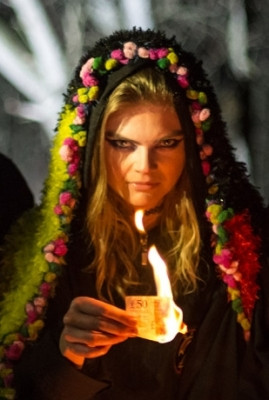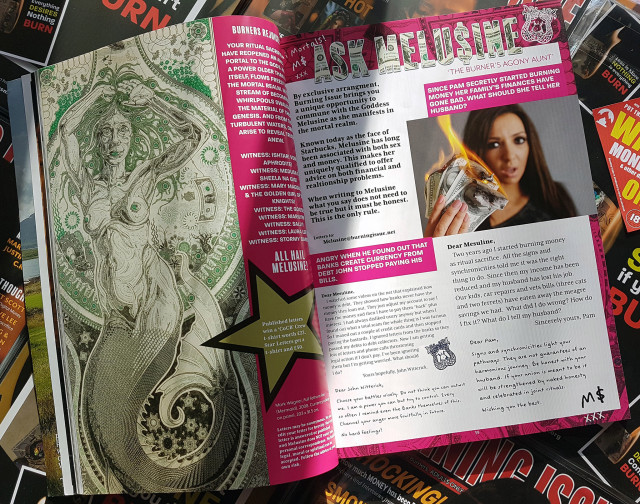What is cryptocurrency if not a “fuck you” to state-backed currency? And what is a “fuck you” to state-backed currency if not burning it?
According to this line of reasoning, money burning and cryptocurrency have something in common. Indeed, the concepts were set to come together on the pages of Burning Issue, a new print magazine about burning money, until its creator, Jonathan Harris, scrapped his bitcoin mining piece—though there’s still a story in there on the topic of burning digital currency. The debut issue of “the world’s first magazine for money burners” also features fashion for fiat-focused pyros, art made of money by the likes of “currency collage” artist C.K. Wilde, and reported stories on fiery rituals.

This first edition of Burning Issue, currently available for $28.23, highlights the most recent “Ritual Mass Burn,” which took place last month on November 3. One hundred people came; about half burned their money—more than £675 in total (roughly $850). Some wore floor-length see-through dresses or dark, hooded cloaks. Others looked like they’d just walked in off the street, in jean jackets and white sweaters. Harris wore a bowler hat and carried a wooden staff.
Harris doesn’t know why people burn money. He makes a point not to ask. “One of the rules I set myself was to never ask or tell anyone to burn their money,” he says over video chat from Welwyn Garden City, about 20 miles outside of London. For Harris, it’s less about why he does it and more a question of, “Why not?”
Harris doesn’t burn money because he espouses a crypto-bro-like enthusiasm for libertarianism. (“I hate seeing things like people promoting guns with little USB sticks you can store your bitcoin on,” he says. “If that is the ultimate expression of freedom, that you can defend your bitcoin stash with a gun—that just seems to me a horrific future.”) In fact, Harris doesn’t appear to be very political at all. He’s more interested in psychoanalytic philosophy, in ritual and sacrifice. Burning money, for him, seems almost like a religion, one leaning far toward the pagan end of the spectrum. It’s a symbolic way to get back to the roots of civilization, for which he believes “sacrifice is the founding act, [and] burning money becomes the primary form of sacrificial ritual.” This makes about as much sense as a holiday where a fat man stuffs himself down your chimney, or an invisible man comes into your house and drinks your wine out of a special cup (if not more sense).
Enter bitcoin into Harris’s money burning philosophy: “You sacrifice all this computing power in the pursuit of the creation of the divine object that is bitcoin,” he says. “There’s a libertarian idea that having your own private property is the basis of freedom, whereas sacrificial logic says that sacrifice and sovereignty are linked.” In other words, bitcoin can please all types of people looking to achieve personal power. However, it’s apparently not very satisfying to burn.
What is satisfying to burn is cold, hard cash, but doing so didn’t catch on as a “mass ritual” until 2015.
“It’s a magical tale, Jessica,” he tells me. He is describing how money burning transformed from his modest, personal hobby into a cultural phenomenon, big enough to occupy London theaters and change the life of well-known Ethereum architect Vinay Gupta.
“I’ll tell you the story if you want,” he says. “Whether you believe it or not, I don’t know. If I go on too long, please just interrupt me.”
Burning money at the 2018 Ritual Mass Burn

He goes on pretty long, but it’s okay. It’s a good story.
“I split up with my missus,” he says. They’d been together a long time and had “a lot of adventures,” including starting a porn site (for which they won an Erotic Award in 2002, five years before Pornhub launched). After she left him in May 2013, Harris spent six months wallowing in his small flat before he came across a fateful blog post by John Higgs, who wrote a book called The KLF: Chaos, Magic and the Band Who Burned a Million Pounds (more on KLF later). The post featured an interview with Youth from a band called Killing Joke. In the interview, Youth talked about how he liked to burn money.
Harris had been burning money by himself in private for six years at that point. Harris also knew Youth from when he (Harris) used to work in the music industry, “driving people around and tour managing and all that sort of thing.”
“It turns out I’d been driving someone around who also burned money,” says Harris, betraying the surprised delight he must have felt during this initial realization. Harris told Higgs, who invited him to a talk he’d be giving about his book along with Robert Anton Wilson, the California-based author of The Illuminatus! Trilogy. Harris described Wilson’s book as “a big cult science fiction classic.” (Side note: Wilson was also friends with Timothy Leary, the 1970s LSD evangelist.) In addition to hearing Wilson and Higgs talk, people were getting together that night to crowdfund a play about Wilson’s life, called “Cosmic Trigger.” It would focus on the idea of performing an action—“For Wilson, it was taking a shitload of LSD,” says Harris—and doing a ritual that “triggers a cosmic change in the universe.”
All of this was to take place on October 23, 2013—Harris’s annual money burning day. Fate, you might call it. Harris calls it “magic,” a “cosmic trigger” that ended up changing his personal universe and that of future money burners everywhere (well, in London, at least).
There are two major instances of mass money burns in recent history. In 1975, right before the last American troops left Vietnam, a group of marines burned piles of money to keep it from getting into the hands of Vietnamese communists. Nearly two decades later, a British art/dance/electronica/pop band called the KLF (thought, by some, to stand for Kopyright Liberation Front) traveled to a remote Scottish island called Jura to incinerate £1 million in cash. “We could have done with the money. We wanted the money,” KLF’s Bill Drummond told a chat show around that time. “But we wanted to burn it more.”
Burning money, for him, seems almost like a religion, one leaning far toward the pagan end of the spectrum.
The KLF’s decision to burn such a large sum of money remains unfathomable. They were a strange band active in the 1980s and 1990s, never quite fitting neatly into any particular genre and going by a variety of names, including the Justified Ancients of Mu Mu, a name that references a secret sect and a lost island from Wilson’s The Illuminatus! Trilogy. Their top hits include “Justified and Ancient,” featuring the American country singer/songwriter Tammy Wynette, and “3am Eternal.” Drummond designed sets for a 1970s theater adaptation of The Illuminatus! Trilogy, a precedent for the “Cosmic Trigger” play.
Ultimately, the crowdfund for “Cosmic Trigger” proved successful, raising more than £25,000, and the play showed in both London and Liverpool in 2014. Through his involvement in the play, Harris met other people who were “open to the ideas of Ritual Sacrifice and Magic that I was exploring in Money Burning,” he wrote to BREAKER in an email. That included Gupta, who was so moved by the performance that he broke a long-held religious vow he had taken about money that eventually led him to Ethereum.
“I would do nothing for money that I was not willing to do for free,” Gupta told BREAKER over email. “I kept [that vow] for more than 12 years.” Gupta identifies as Nath Sampradaya, a sub-tradition within Hinduism. “Cosmic Trigger” made him reevaluate its doctrine.
Burning money at the 2018 Mass Ritual Burn

“Robert Anton Wilson had a big effect on him,” Harris says of Gupta, “and how he viewed his life and what he was doing. It was after that that he got involved in Ethereum.” In a sense, then, you could say that the same concepts that inspired a culture of burning money brought us one of crypto’s broadest thinkers. Magic.
The next year, Harris performed a money burn with one other person on August 23, the anniversary of the KLF’s massive burn. The following morning, he happened to get an email from the Cube Cinema in Bristol, “a social art experiment” disguised as a movie theater, asking him to attend their “KLF Night” that November so he could lead a money burn during the event. “That was the first ever Ritual Mass Burn, and over £1,000 (then about $1,500) was destroyed by about 70 people,” he says. (Burning money, it turns out, is technically legal in the U.K.)
Harris was bankrupt when he first burned money in 2007. He decided to set £10 on fire (then about $20). “It didn’t seem like a big deal, really, deciding how to spend or get rid of 10 quid,” he said. “Immediately on doing it, I was aware that it was a form of ritual and a form of sacrifice.”
The year after that, he burned £20, still all by himself. “That was good,” he says, his voice full of nostalgia. “That was a good one.” The year after that, he went for £50. It “hurt a lot.” That was the same year he first heard about bitcoin from a blog by Jon Matonis, an early Bitcoin Foundation executive. For someone who’s interested in burning money, a symbol of the centralized government, surely cryptocurrency would prove an interesting alternative to fiat currency.
The egalitarian promise of bitcoin did appeal to Harris. “Those original visions of people mining on their own computers and it being used as a currency and spread around were wonderful,” he says. “But that’s not what happened, unfortunately.” Instead, Harris saw bitcoin regularly used as a type of investment vehicle, which didn’t interest him. Today, he figures he still has “maybe 0.5 BTC” on an old hard drive under his bed, “back from when it was being given away to encourage people to use it.”
Burning Issue magazine

Then there was the 1.75 bitcoin his former father-in-law gave him for Christmas back in 2014, just before a price hike. It’s long gone. Harris ended up trading it in for some Neucoin, a failed proof-of-stake experiment created from a Peercoin fork that’s since proven worthless. “I haven’t got a great record, I’m afraid.”
Though Harris’s poor bitcoin trading effectively caused it to disappear, that’s not the same as a ritual sacrifice. So how does one sacrifice bitcoin?
“Ohhh now there’s a question,” says Harris. You could almost hear him rubbing his hands together, set to expound.
“Okay, well. Crypto and digital currency are different things. Burning digital currency is pretty much impossible. You have to basically create a bank and burn it, which is quite tricky.”
So, crypto?
It’s been done before, by the artist Geraldine Juarez at the start of 2014, kicking off the year in which Gupta met Harris and ultimately decided to get into Ethereum. She may have, almost certainly unbeknownst to her, enacted a “cosmic trigger.”
“What makes a currency real?” Juarez asked in a description of her performance. “When we are able to burn them [sic] for real, of course.” Juarez put 0.00977616 BTC onto an SD memory card and set it on fire. Like magic, it became real.
For Harris, a veteran money burner, incinerating bitcoin just doesn’t scratch that sacrificial itch.
“It’s not as much fun as burning paper money, I got to say. Those ritual elements really help. [Burning bitcoin] was okay, it was cool, but actually having a burning, flaming—I mean you can imagine. Wiping off a hundred dollars in cryptocurrency is one thing, but having a nice, crisp $100 bill in your hand is going to have a slightly different effect,” he said.
There’s an irony inherent in creating a commercial magazine dedicated to the act of burning money. Harris “wants to make a profit” from Burning Issue, “because I’d rather do that than the job I’m doing” (Harris drives a van).
For now, however, Harris says the magazine “is just a massive money sink for me, to be honest.” There is, after all, more than one way to burn money.
Photos by Jonathan Greet, courtesy of Jonathan Harris.